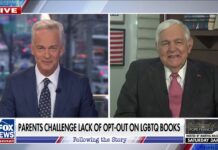
This post discusses the plot of Cruella.
Once Hollywood realized that representation was good for box office, every new Disney property was suddenly breaking new ground. The 101 Dalmations prequel Cruella is just the latest in a series of Mouse House releases accompanied by industry crowing about a groundbreaking LGBTQ+ character, and the déjà vu reading headlines like this one is so intense it’s starting to feel like gaslighting. For the past five years, a series of stories have run on entertainment news sites, with only a few words changed: Swap out “Disney’s first LGBTQ+ character” with “Pixar’s,” or “Marvel Studios’,” add a modifier here and there, and they’re all cut and paste versions of the same hollow sentiment. Not only is Disney not a leader on this issue, it’s quickly falling behind.
Advertisement
For Cruella, the line is that Artie (John McCrea) is Disney’s first “major” gay character, which is only true if you don’t count Josh Gad’s LeFou in the live-action Beauty And The Beast. Even then, it’s only on a technicality: The same language was used to describe a character in Jungle Cruise in 2018, and if that long-delayed film had come out on time, the “hugely effete, very camp” brother of Emily Blunt’s Dr. Lily Houghton would have taken the prize.
In Cruella, Artie is the quippy, down-for-anything owner of a vintage shop in a fashionable area of London. Artie’s gender presentation is ambiguous (“he” pronouns are used to refer to him in the movie) and his Ziggy Stardust mullet and lightning-bolt makeup marks him as a devotee of the glam rock movement that blurred the binary in the early- to mid-’70s. His wardrobe of sheer blouses, velvet jumpsuits, and platform shoes prompts Estella (Emma Stone), the fashionista soon to be known as Cruella de Vil, to ask, “how’s that look go on the streets?,” the first time they meet in his store. “Some abuse and insults, of course, but I like to say that ‘normal’ is the cruelest insult of them all. And at least I never get that,” he replies.
It’s never explicitly stated that Artie is queer, although we’re supposed to infer as much from his comment that the racks of couture gowns in his store are “everything a girl—or boy—could ever want.” And that’s misleading, not only because gender and sexuality are two different things, but because the glam rock movement was more heteronormative than the frills and heels would lead one to expect. Trumpeting an androgynous glam rocker as queer representation isn’t incorrect—fluid sexuality was downright chic in glam circles—but plenty of straight people dressed like Marc Bolan in 1975, too. McCrea has acknowledged this, saying that “I think it’s important to say he is queer because obviously, lots of people were dressed like that at the time that weren’t necessarily queer, but in my head, he always was,” in an interview with the U.K.’s Gay Times.
But while Artie’s sexual identity is fixed in McCrea’s head, the fact that “glam” and “gay” are not and never were synonymous also gives Disney an easy out. Determined to appeal to as many demographics as possible, the company craves positive press for its inclusivity, but is too timid to openly thumb its nose at the homophobes in the audience. Artie’s part can’t be cut out of Cruella as easily as the “exclusively gay moment” in Beauty And The Beast, which lasts for literally two seconds. But if it was challenged by censors in say, China, where homosexuality is legal but films with LGBTQ+ themes are still subject to cuts, plausible deniability about Artie’s sexuality could still be maintained. McCrea has said in interviews that the character was originally written as a drag queen, a form of expression that can’t be so easily untangled from gay culture. The fact that this detail was changed speaks to the fact that while Disney is loud about tooting its own representational horn, it prefers its LGBTQ+ characters to stay discreet.
G/O Media may get a commission
Artie doesn’t have a love interest in Cruella, and to be fair, Cruella doesn’t either. McCrea says that this is the movie “not beating you on the head with a stick. But [Artie’s] lifestyle is fabulous, he loves his life and it was so fun to play him.” And that’s fine. Romantic love is but one of the many types of relationships that make up a full life, and a queer person doesn’t need to be partnered for their queerness to be valid. But the nuances of conveying that a character is LGBTQ+ without either relying on stereotypes or having them engage in an onscreen romance is, frankly, beyond Disney’s capabilities at this point.
Even when it comes to (chaste, family-friendly) queer romance, the best the company’s subsidiaries have been able to do is a blink-and-you’ll-miss-it kiss between two women in Star Wars: Episode IX—The Rise Of Skywalker. In its films, Disney prefers offhand remarks about spouses who are safely kept offscreen, like the throwaway line in Onward where a one-eyed purple cop with a unicorn horn says, “It’s not easy being a new parent—my girlfriend’s daughter got me pulling my hair out.” If a LGBTQ+ character’s spouse is dead, even better—like the much-ballyhooed “first gay character in the MCU,” a traumatized man in Avengers: Endgame who tells a support group about how he burst into tears on a date five years after losing his husband to Thanos’ Snap.
Advertisement
An LGBTQ+ couple can appear together on screen if the characters don’t speak, like the moms seen in the background picking their kid up from school in Toy Story 4 or the squabbling antelopes in Zootopia you wouldn’t know are married unless you pay close attention to the credits. These characters are disposable, and so is Artie, who appears in Cruella whenever Emma Stone’s character, regardless of what name she’s going by, needs a quick hit of fashion credibility. Once Artie is introduced, he drops out of the story for a while, only to be re-introduced after Estella debuts her her latest and most fabulous creation: Her alter ego, Cruella de Vil.
What happens next is far more objectionable than Artie’s lack of a love interest. Although they’re framed as fashion soul mates, Cruella has little use for the character of Artie beyond serving as a stylish prop. The thing that pushed the villain formerly known as Estella to become Cruella was her anger over having someone else take credit for her work, but she seems perfectly happy to do the same thing when Artie joins her crew as a seamster. From then on, he’s content to stay in the background of Cruella’s workshop, leading the team that cuts and sews the outfits she will later present as her own creations. He doesn’t complain about Cruella’s lack of gratitude, like Joel Fry’s Jasper; no, simple proximity to a fashionable woman is enough for him. By the end of the movie, he’s become a full-fledged henchman, seen karate chopping a security guard who threatens his boss’ master plan. His reward for his loyalty? He gets to move into her manor and work for her some more. It’s true that assistants create most everything in the art world, from hand-beaded gowns to abstract paintings. But even in fiction, where the injustices and inequalities of the real world only apply if a creator puts them there, a person like Artie is a means to an end—for Cruella and for Disney.
Advertisement
Disney has learned a few things over its eight attempts to get its “first” LGBTQ+ character right: Unlike Jack Whitehall, the straight actor cast as Jungle Cruise’s “first major gay character,” McCrea identifies as a gay man, which makes the bejeweled pill of his Cruella character a little easier to swallow. McCrea’s comments in the press are all defending the film and his role in it, which is to be expected; if McCrea has dissenting opinions about Cruella’s treatment of his character, he’s no more likely to air them publicly than an Avenger is to leak a major spoiler on TV. Actors are coached and given lengthy lists of what they can and cannot talk about when promoting films like Cruella, and it’s not McCrea’s job to fix Disney’s poor track record of LGBTQ+ representation, besides. But he did reveal one telling detail in an interview with Attitude where, asked directly if the character is LGBTQ+, he says, “it depends on who you’re asking, I suppose.”
Seizing on subtle hints and winking implications and making them part of the camp canon has long been a strategy for LGBTQ+ audiences starved to see themselves on the big screen. But it’s cowardly for for a major film studio to expect them to do this in an era where, as Dani di Placido points out in Forbes, successful children’s shows like Adventure Time, Steven Universe, and Kipo And The Age Of Wonderbeasts feature out and proud queer characters. And if Disney thinks its strategy isn’t being noticed, let us disabuse it of this notion. A wave of canned hype about the “first” in Cruella was met with intense mockery online, with one user tweeting:
Advertisement
By letting its fear of offending the most retrograde elements of its audience dictate how it approaches its LGBTQ+ characters, Disney is out of touch with a vast audience that craves depictions of queer people as fully rounded human beings in stories that center their experiences. And expecting to be celebrated for doing the bare minimum is insulting—to the fans, to the press, and to the films themselves. If Disney wants its attempts at LGBTQ+ representation to ever be anything more than performative, it’s going to have to start treating these characters like Fashion Week showstoppers, not fast fashion throwaways.
Advertisement







